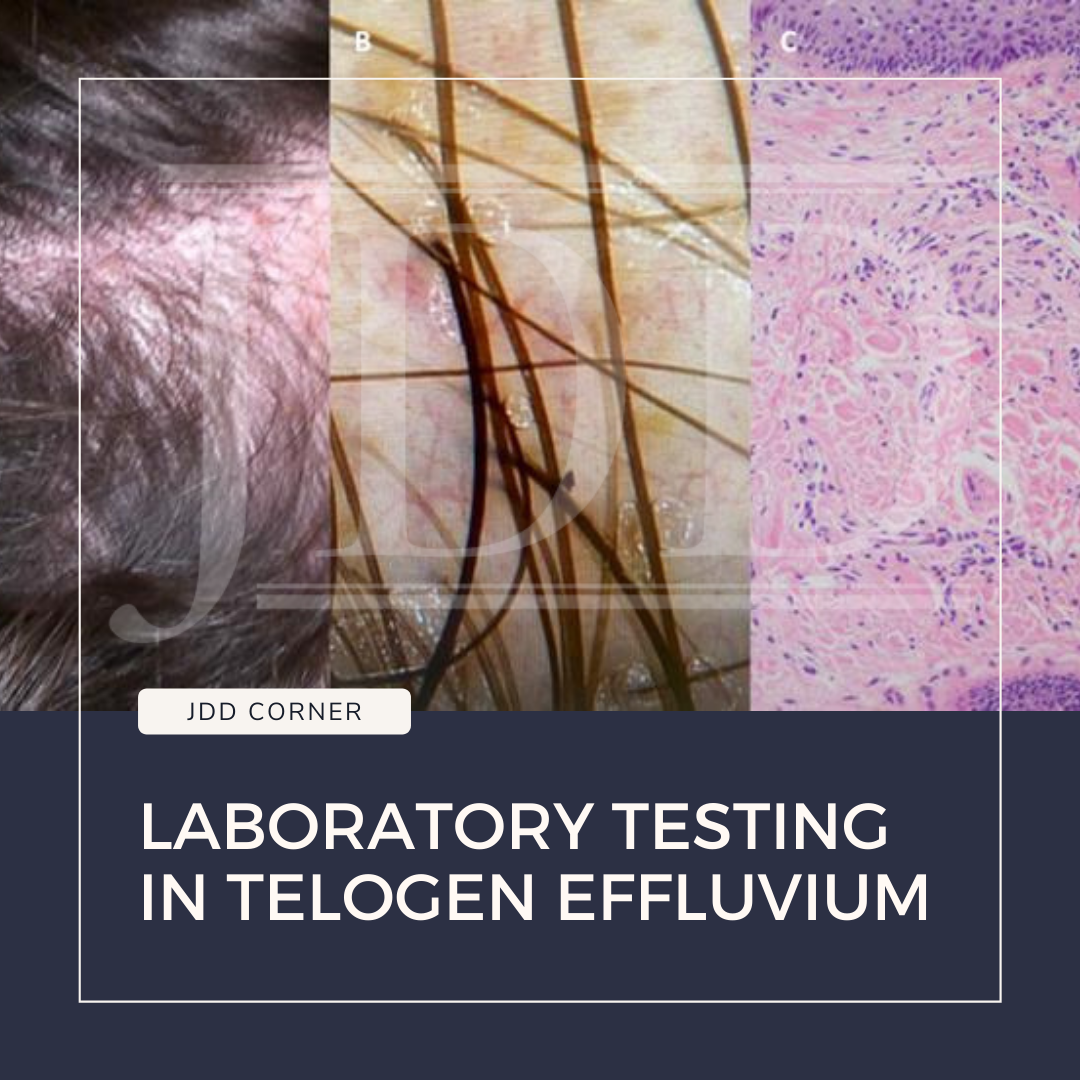INTRODUCTION
Telogen effluvium (TE) – a common cause of non-scarring hair loss – is managed with varying clinical protocols given the paucity of evidence-based practices. While endocrine, vitamin, and mineral abnormalities have been implicated in TE, whether laboratory testing changes management or improves outcomes remains unclear. However, laboratory testing in dermatologic conditions will be under increased scrutiny by payors and administrators.1 This article identifies 5 serum laboratory tests commonly performed for TE and examines the evidence supporting their use.
Ferritin
Iron deficiency is commonly associated with TE with ferritin measuring the body’s iron stores.2,3 Aside from observational reports, there are few controlled human studies linking low ferritin (<40 μg/L) levels to TE.4 Rather, a widely cited controlled study demonstrated no difference in ferritin values regardless of the cutoff value.5 While one group has reported that supplementation with iron and L-lysine may reduce hair shedding or telogen hairs, there is no controlled study demonstrating that iron supplementation leads to hair regrowth in TE, with or without iron deficiency anemia.2Although controversial, iron supplementation in the absence of anemia is not recommended by some hematologic experts.2
Iron Deficiency Anemia
Iron deficiency anemia (IDA) is a downstream effect of long term iron deficiency.2 Several uncontrolled studies with small test populations have demonstrated high rates of anemia amongst TE patients,6 however a major controlled study found no difference in hemoglobin levels in patients with chronic TE and the control populations.5 It is unclear whether population prevalence estimates of IDA are any different from controlled studies of subjects with TE.2 While no studies have demonstrated that iron supplementation promotes hair regrowth in the setting of TE, when identified, IDA should be treated as the causes may range from heavy menstrual bleeding to malignant intestinal bleeding.
Vitamin D
Vitamin D has many pivotal roles for hair follicle development,7however the association between vitamin D deficiency and TE is unclear. A prospective, case-controlled study found that vitamin D levels were significantly lower in TE patients, especially in more severe deficiency.4 However, a review highlighted the lack of evidence supporting vitamin D supplementation by reporting contrasting studies with higher and lower rates of vitamin D deficiency amongst TE patients.7Furthermore, vitamin D levels may fluctuate based on seasonal changes and ethnicity.8
Thyroid Stimulating Hormone
Thyroid disease is commonly listed as a cause of hair loss, including TE. The widely cited reference study from 1972 examined thyroid hormone replacement in 9 patients with hair loss and hypothyroidism and found higher rates of telogen hairs at baseline with replacement leading to decreased proportion of telogen hairs.9 Conversely, a longitudinal study of patients with chronic TE found that hair shedding continued despite treatment for hypothyroidism in 3 patients.10 A case-controlled study reported that 24% of chronic TE patients had high levels of thyroperoxidase antibodies,11 but found a low prevalence of hyper- or hypothyroidism amongst these subjects. Treatment of thyroid disorders in patients with TE also has not been further examined on a larger scale.
Zinc
A case series of 5 patients concluded that zinc supplementation in patients with TE led to increased hair growth.12 However, the authors acknowledge that 4 of these patients may have had alopecia areata, rather than TE. Furthermore, the small sample size limits the validity and generalizability of these results. Several other case-controlled studies have examined zinc levels in patients with TE with mixed results.
CONCLUSION
DISCLOSURES
REFERENCES
-
- Coldiron BM, Fischoff RM. American Academy of Dermatology Choosing Wisely List: helping dermatologists and their patients make smart decisions about their care and treatment. J Am Acad Dermatol. 2013;69(6):1002.
- Trost LB, Bergfeld WF, Calogeras E. The diagnosis and treatment of iron deficiency and its potential relationship to hair loss. J Am Acad Dermatol. 2006;54(5):824-844.
- St Pierre SA, Vercellotti GM, Donovan JC, Hordinsky MK. Iron deficiency and diffuse nonscarring scalp alopecia in women: more pieces to the puzzle. J Am Acad Dermatol.2010;63(6):1070-1076.
- Rasheed H, Mahgoub D, Hegazy R, et al. Serum ferritin and vitamin d in female hair loss: do they play a role? Skin Pharmacol Physiol. 2013;26(2):101-107.
- Olsen EA, Reed KB, Cacchio PB, Caudill L. Iron deficiency in female pattern hair loss, chronic telogen effluvium, and control groups. J Am Acad Dermatol. 2010;63(6):991-999.
- Poonia K, Thami GP, Bhalla M, Jaiswal S, Sandhu J. NonScarring diffuse hair loss in women: A clinico-etiological study from tertiary care center in North- West India. J Cosmet Dermatol. 2019;18(1):401-407.
- Gerkowicz A, Chyl-Surdacka K, Krasowska D, Chodorowska G. The role of vitamin D in non-scarring alopecia. Int J Mol Sci. 2017;18(12).
- Cashman KD, Dowling KG, Skrabakova Z, et al. Vitamin D deficiency in Europe: pandemic? Am J Clin Nutr.2016;103(4):1033-1044.
- Freinkel RK, Freinkel N. Hair growth and alopecia in hypothyroidism. Arch Dermatol. 1972;106(3):349-352.
- Sinclair R. Chronic telogen effluvium: a study of 5 patients over 7 years. J Am Acad Dermatol. 2005;52(2 Suppl 1):12-16.
- Baldari M, Guarrera M, Rebora A. Thyroid peroxidase antibodies in patients with telogen effluvium. J Eur Acad Dermatol Venereol. 2010;24(8):980-982.
- Karashima T, Tsuruta D, Hamada T, et al. Oral zinc therapy for zinc deficiency-related telogen effluvium. Dermatol Ther. 2012;25(2):210-213.
SOURCE
Kakpovbia, E., Ogbechie-Godec, O. A., Shapiro, J., Lo Sicco, K. I (2021). Laboratory Testing in Telogen Effluvium. Journal of drugs in dermatology: JDD, 20(1), 76-83.
Featured Image Credit: https://jddonline.com/articles/presentation-and-management-of-cutaneous-manifestations-of-covid-19-S1545961621P0076X/
Content and images used with permission from the Journal of Drugs in Dermatology.
Adapted from original article for length and style.

